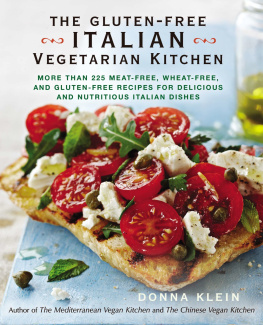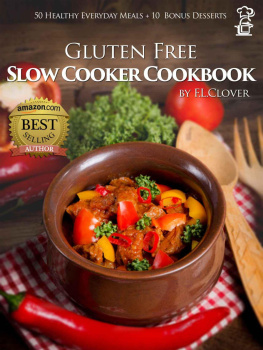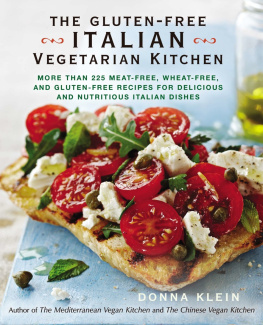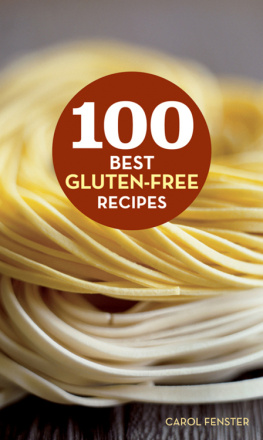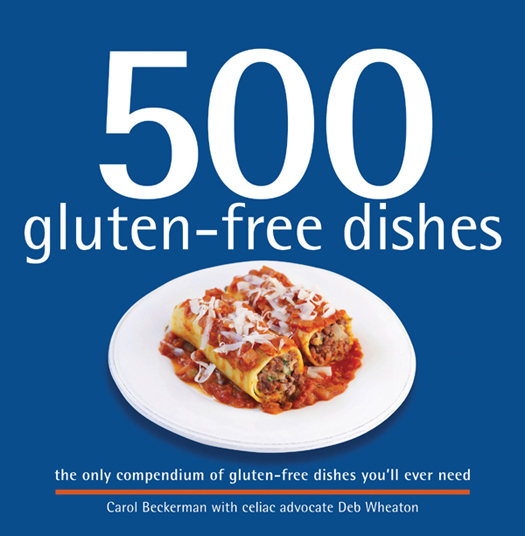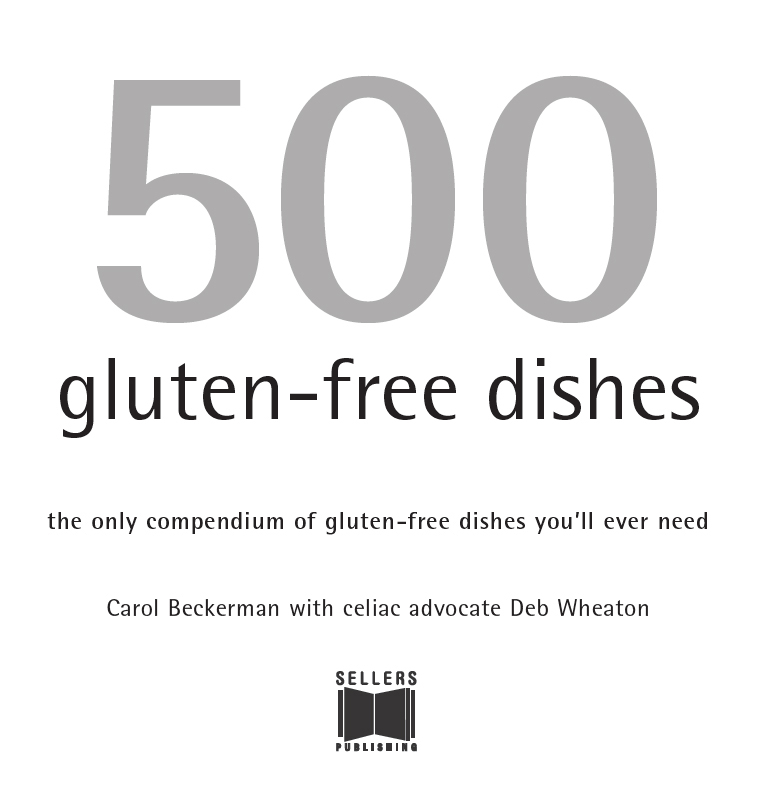
A Quintet Book
Published by Sellers Publishing Inc.
161 John Roberts Road, South Portland, Maine 04106
Visit our Web site:
e-ISBN: 978-1-4162-0854-9
500 Gluten-Free Dishes copyright 2013 Quintet Publishing Limited. All rights reserved under International and Pan-American copyright conventions. By payment of the required fees, you have been granted the nonexclusive, nontransferable right to access and read the text of this e-book onscreen. No part of this text may be reproduced, transmitted, downloaded, decompiled, reverse engineered, or stored or introduced into any information storage and retrieval system, in any form, by any means, whether electronic or mechanical, now known or hereinafter invented, without the express written permission of Sellers Publishing, Inc. e-books.
March 2013
This book was designed and produced by
Quintet Publishing Limited
6 Blundell Street
London N7 9BH
United Kingdom
Food Stylist: Jayne Cross
Photographer: John Whittaker
Art Director: Michael Charles
Editorial Director: Donna Gregory
Publisher: Mark Searle
contents
introduction
It certainly seems as if everyone is talking about Going Gluten-Free these days. Maybe thats why you picked up this book today. Maybe you, or someone close to you, has been recently diagnosed with celiac disease or gluten-sensitivity. The reasons for going gluten-free are many. Besides celiac disease, reasons for considering a gluten-free diet vary from a simple cleanse to a serious and sometimes controversial weight loss program, as well as a treatment for autism and ADHD. Additionally, the newest research identifies a spectrum of gluten-sensitivity, with researchers proposing new nomenclature and classification of gluten-related disorders.
No matter where you find yourself on the spectrum of gluten-intolerance, whether it be celiac, wheat allergy, gluten-intolerance or sensitivity, your treatment will be the same: a gluten-free diet.
This book will demystify the process and get you on your way to enjoying a healthful and satisfying gluten-free lifestyle. The photos that accompany the hundreds of irresistible recipes here will remind you that we eat with our eyes first. In addition to a celiac and gluten-intolerant overview, you will find hints for stocking your pantry and creating a safe cooking space. All of it designed around easy to follow recipes that the whole family will enjoy.
Due to increased awareness, the desire for gluten-free products is growing daily. More gluten-free options are flooding the market as manufacturers step up to address the increasing consumer demand. One trip to the super market will reveal the extent to which manufacturers are appealing to the expanding gluten-free consumer. There is no need for despair; as you are about to learn, there has never been a better time to be gluten-free!
celiac disease
In 2005, my daughter and I were diagnosed with an incurable disease And weve been celebrating ever since. Such a bold statement begs an explanation, right? My daughter and I have celiac disease.
what is celiac disease?
It was a London pediatrician, Dr. Samuel Gee, who first put celiac (also called coeliac) on the map in 1888 when he defined the symptoms in children with incredible accuracy and connected it to diet. In the 1950s, gluten was identified as the culprit, but it wasnt until the 1970s that the genetic markers were identified. We now know that celiac disease is a serious genetic autoimmune disease manifested by a complete intolerance to all foods containing gluten. Gluten is the storage protein found in wheat, rye, and barley. Its what makes flour sticky and gives bread its unique structure. But for celiacs, even a crumb of gluten-containing food can cause a severe reaction.
what are the symptoms?
Probably the most common and classic symptoms of celiac will be gastrointestinal. However, celiac disease is a multi-system, multi-symptom disorder. Symptoms vary and are not always gastrointestinal. Common symptoms include: bloating, diarrhea and/or constipation, migraine headaches, brain fog, fatigue, infertility and pregnancy complications, migraine headaches, joint and bone pain, anemia and slow growth in childhood. There is also a skin manifestation of celiac called dermatitis herpetiformis (DH), characterized by a blistering, intensely itchy skin. DH patients can also have intestinal damage without obvious gastrointestinal symptoms. If left undiagnosed, related serious diseases associated with celiac include: rheumatoid arthritis, insulin-dependent type I diabetes, osteoporosis, thyroid disease, lupus, liver diseases and certain types of cancer.
Celiac is the no.1 genetic autoimmune disease on the planet, as well as being the most under-diagnosed and/or misdiagnosed disease. In fact, 97% of all celiacs dont even know they have a potentially life-threatening disease. The average delay in diagnosis in adults is 9 years.
so why are we celebrating?
Celiac is the only disease in the world completely controlled by diet. Specifically and simply a gluten-free diet! And that is cause for celebration. 500 Gluten-Free Dishes will help to demystify the process and get you on your way.
On a gluten-free diet my daughter and I are leading normal, healthy lives. We have our lives back! Adhering to a strict gluten-free diet, it is very unlikely that we will suffer from any of the secondary diseases associated with undiagnosed celiac disease.
what is gluten-sensitivity?
There are also an increasing number of people who experience a celiac-like reaction to gluten without the positive serology or intestinal damage. Those who experience distress after consuming gluten and improvement after removing it from their diet, are now being diagnosed under the umbrella of gluten-sensitive.
The newest research identifies a spectrum of gluten-sensitivity with researchers proposing new nomenclature and classification of gluten-related disorders. If you test negative for celiac but still react after eating gluten, perhaps you fall into this category.
a word about gluten-free oats
Oats are often found on the avoid list for a gluten-free diet. The fact is that oats are naturally gluten-free but often cross-contaminated in the field. Oats are often grown near wheat fields and historically might be part of the crop rotation cycle with other gluten containing grains. Research shows that the majority of celiacs can tolerate certified gluten-free oats, and oats are encouraged as part of a balanced gluten-diet as they add protein, fiber and variety. Because of the added protein, GF oat flour is also a great substitute for wheat flour. However, it is true that a segment of the celiac community remains intolerant to even the cleanest, gluten-free oats. My daughter and I unfortunately fell into this population. But new research has given us hope to get oats back into our lives. It seems that most oats have hulls which are very high in a protein called G12. And it seems that it might be this avenin peptide in hulled oats that causes a reaction with GF oats. The fact is that some gluten-free oats test very high in this protein. So even if they are grown in a completely gluten-free environment, they can still be intolerable to some sensitive individuals; celiacs and gluten-intolerants alike. There is a variety called Avena nuda L. This is a naturally hull-less oat which is very low is the avenin peptide that might be the cause or a gluten-like reaction. My daughter and I have found that we can both tolerate it well, and oats and oat flour are now a part of our daily GF diet. It you can tolerate oats; the is a healthful addition to any diet.







